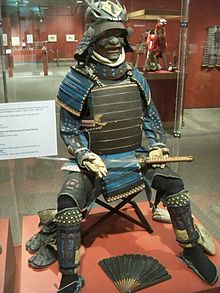Tōseigusoku
Tōseigusoku ( Japanese 当 世 具足 , dt. "Modern armor") is a collective term for Japanese armor , as it was common from the end of the Muromachi period and during the Azuchi-Momoyama period , ie during the Sengoku period or in 16th century .
description
The designation tōsei , "modern", was given to the armor types at this time in order to distinguish them by name from the armor common up to then such as dōmaru and haramaki . The main reasons for the development were changes in war tactics, the advancement of weapons technology, including the introduction of the rifle, and the influence of Western armaments that came to Japan with the Nanban trade . The Sengoku period brought new demands on armaments construction: in order to be able to equip large armies, armor should be easy to manufacture and easy to wear without extensive training. The introduction of firearms, on the other hand, required armor that was able to protect against bullets. Various new construction methods based on connected segments were therefore used. The great need for war equipment of this time resulted in a multitude of different types of armor, the most important are the Okegawadō ( 桶 側 胴 ), the Nanbandō , the Hotokedō ( 仏 胴 ) and the Mogamidō ( 最 上 胴 ), but also the Tatamidō . For the construction of the dōmaru , which has been in use since the Heian period , iron-shod leather plates, so-called kogans ( 小札 ), which were connected both horizontally and vertically with cords, were used. This type of production required extensive manual work. In order to simplify this work, larger segments were used, either wider iron-shod leather strips, so-called itazane (see below), metal strips or even (based on the European model) chain mesh like the Tatamidō or a cuirass like the Nanbandō. In order to increase the protective effect, the breastplate was constructed in three parts : a belly protection ( 長 側 , nagakawa ), a chest protection ( 前 立 挙 , mae-tateage ) and a back protection ( 後 立 挙 , ushiro-tateage ). The armor was supplemented by the face protection Mempō ( 面 頬 ), the thigh protection Haidate ( 佩 楯 ), and others. The predecessor, the Dōmaru, was only in two parts.
A helmet ( Kabuto ) also belonged to a Tōseigusoku . There was also a variety of shapes with some very splendid decorations. Not only the purely practical use played a role, it also reflected the social and military status and the individual character of the individual warrior ( Bushi ).
literature
- Ian Bottomley, Anthony Hopson: Arms and Armor of the Samurai. The History of Weaponry in Ancient Japan. Crescent Books, New York NY 1994, ISBN 0-517-10318-4 .
